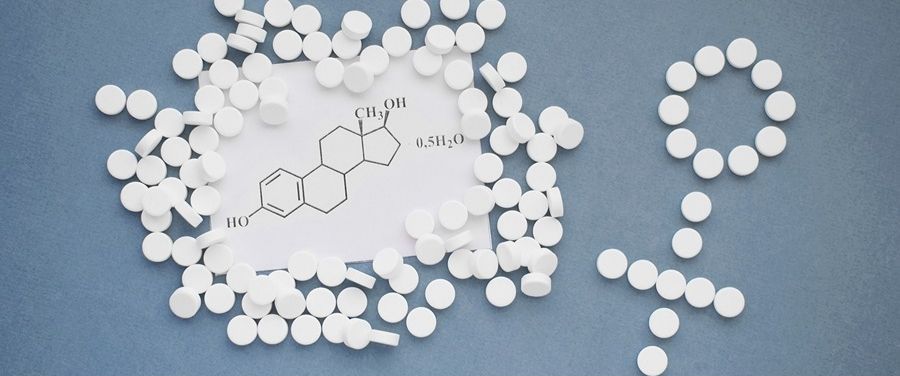Formula— C18H24O2
CAS ID— 50-28-2
Molar Mass— 272.38 g/mol
Classification— Estrogen
Generic Name(s)— Estradiol
Brand Name(s)— Estrace, Vivelle-Dot, Delestrogen, Climara, DepoEstradiol, Alora, Estrace Cream, Divigel, Elestrin, Estraderm Transdermal, estradiol topical, Estradot, Estrogel, Evamist, Estrasorb, Femtrace, Menostar, Minivelle, Vivelle
What is Estradiol?
Estradiol (E2), also known as oestradiol, is a major female sex hormone or estrogen hormone which plays an important role in the female reproductive system. It is used to regulate estrous and menstrual female reproductive cycles.
The hormone also plays a vital role in the development of female secondary sexual characteristics including widening of the hips, breasts, and a female-associated pattern of fat distribution.
It is also responsible for the development and maintenance of female reproductive tissues such as uterus, mammary glands, and vagina during adulthood, puberty and pregnancy. [Trusted Source]
It also has other important effects in many other tissues such as bone, liver, fat, skin and the brain.
However, in males the levels of estradiol are much lower as compared to those in females. But, it has important roles in men as well.
Estradiol Uses:
It is used by women to decrease the vaginal symptoms of menopause including vaginal dryness, burning or itching. If these symptoms occur, it means that the body is making less estrogen.
While curing only vaginal symptoms of menopause, it may applied directly inside the vagina. Estrogens that are taken by mouth, injected or absorbed through the skin may have higher risks of side-effects due to more estrogen being absorbed.
Estradiol Side-Effects:
Side-effects associated with the use of estradiol, include the following —
- Abdominal cramping
- Delayed ejaculation
- Depression
- Dry mouth
- Excessive thirst
- Anxiety
- Bloating
- Breakthrough bleeding
- Breast enlargement
- Breast tenderness,pain or swelling
- Freckles or darkening of facial skin
- Changes in menstrual periods
- Fainting or lightheadedness
- Headache
- Vomiting
- Weight changes
- High blood pressure (hypertension)
- Impotence
- Influenza
- Stomach upset
- Swelling
- Swelling of extremities
- Itching
- Loss of scalp hair
- Missed menstrual periods
- Muscle cramps
- Nausea
- Nervousness
- Toothache
- Vaginal discharge
- Rash
- Skin irritation and redness at application site (transdermal)
- Spotting
- Stomach cramps
- Vaginal erosion, vaginal discomfort, vaginal ulceration
Interactions:
Your doctor may already be aware of any possible interactions. If you’re going to start this medication Tell your doctor about the medicines or drugs you are taking currently.
Do not stop, start or change the dosage of any medicine. Ask your doctor before doing so.
Some products that may interact with this drug include —
- Fulvestrant
- Ospemifene
- Raloxifene
- Tamoxifen
- Toremifene
- Tranexamic acid
- Aromatase inhibitors; such as anastrozole, exemestane, letrozole
Overdose:
Symptoms of overdose may include —
- Severe nausea
- Vomiting
- Unusual vaginal bleeding
If someone has taken an overdose of estradiol and has serious symptoms such as passing out or trouble breathing, ask your doctor or health care provider immediately.
Precautions:
Before taking this medication, tell your doctor if you are allergic to it; or if you have the history of any other allergy. It’s because the product may have inactive ingredients, which can cause allergic reactions.
Before using this medication, tell your doctor or health care provider your medical history; especially of —
- Vaginal bleeding of unknown cause
- Blood clots
- Stroke
- Asthma
- Seizures
- Cardiovascular diseases, such as heart attack
- Liver diseases
- Kidney disease
- High blood pressure
- Diabetes
- Obesity
- Lupus
- Hypothyroidism
- Mineral imbalance
- Gallbladder disease
- Certain cancers such as breast cancer, uterus cancer or ovary cancer
- Blood clotting disorders; such as protein C or protein S deficiency
- Migraine headaches
- Mental disorders; such as dementia, depression
- High cholesterol or triglyceride levels
- Family medical history; especially breast lumps, cancer or blood clots
Avoid the use of tobacco as estrogens may combined with smoking further increases the risk of stroke, high blood pressure, blood clots and heart attack, especially in women older than 35 years.
Children may be more sensitive to the side-effects of this drug. It may affect their development or growth.
This medication is also not recommended for pregnant women. If you’re pregnant, tell your doctor right away.
Consult your doctor if you are breast—feeding. This medication passes into the breast milk and may reduce the quality and quantity of breast milk produced.
RELATED ARTICLES:
- Paroxetine Uses, Dosage And Side Effects
- Guaifenesin Uses, Dosage and Side-Effects
- Atropa Belladonna : Uses, Side-Effects, Dosage And Precautions
- Coenzyme Q10 (CoQ10) : Uses, Side Effects, Deficiency, Interaction, Dosage and Benefits
- Leukorrhea : Causes, Symptoms and Effective Treatments
- Loose Vagina : Causes, How to Tighten Up, Kegal Exercise and More
- Fishy Vaginal Odor : Get Rid of Smelly Vagina
